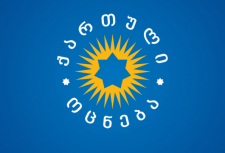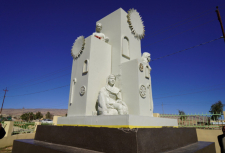Yezidism – its background observances and textual tradition

Philip G. Kreyenbroek
Part 3
The present book does not claim to be in any way a definitive study of Yezidism. It is frankly the work of a male Iranist, whose personal observations are based on limited periods of intensive contact with one Yezidi community, that of Sheykhan in Northern Iraq, and on interviews in Europe with a small number of members of various communities over a longer period of time. To a large extent, the first part of the book consists of a reinterpretation of available material in the light of new insights derived from these contacts and from a study of the Qewls. The world of the Yezidi women of Northern Iraq is closed to a male foreigner, this has resulted in a rather glaring lacuna in the book which, it is hoped, will one day be filled by an author of the appropriate sex.
I was privileged to visit the Yezidi community in the Safe Haven of Northern Iraq for some weeks in March and April 1992 and again in September and October of that year. Although these visits proved illuminating in many other respects, their main purpose was to work on the oral texts of the Yezidi s. On both occasions Pir Khidr Sileman and other members of the community gave unstintingly of their time, helping me to translate their sacred texts—which for the most part they had always understood approximately and intuitively—in the precise manner demanded by Western scholarship. This was by no means an easy task. First of all, the Qewls are difficult by any standard, using an allusive style and many words and references which are obscure to outsiders and not always intelligible to modern Yezidis. Each informant, moreover, naturally tended to feel certain of Ms own interpretation, while only a few saw the force of considerations which seemed crucial to a Westerner. The result of this joint labour is published in the second part of this book—admittedly a small sample of the vast corpus of texts but, it is thought, a representative one. Because of the various difficulties involved—not the least of which is caused by the relative poverty of lexicographic data—the meaning of some passages, words and references has remained unclear, while translations which seem to yield good sense may need to be revised as more Yezidi Qewls—and more Kurdish dictionaries—are published. Although I must take responsibility for the final edition, translation and commentary of the texts, this part of the work could not have been written without the indefatigable help of Pit Khidr Sileman.
The transcription of names and technical terms posed considerable problems. Many prominent Yezidi figures began life as Muslims, with Arabic names, and a large number of technical terms also derive from Arabic. In the course of time, however, the dominant language of the Yezidi tradition came to be Kurmanji Kurdish. The problem is that the usual systems of transcribing Arabic differ fundamentally from the accepted Roman transcription of Kurmanji. Also, experience tends show that the latter, which is based on Turkish orthography, seems particularly impenetrable to readers who are unfamiliar with Kurdish or Turkish. This transcription, moreover, disregards differences between consonants which are distinct in Arabic but are pronounced alike in most dialects of Kurdish. These differences are largely preserved when the Kurmanji of Northern Iraq is written in the Arabic alphabet, and they can help to identify the origin of a word.
Because of all this, it was not possible to adopt a single system of transcription. When Kurdish words or short phrases occur in the English text—but not in longer sentences, or in discussions of linguistic points in the Commentary to the Texts— an adapted version of the standard transcription of Kurmanji is used, with 'sh' for '5', 'kh' for 'x 'j' for 'c 'ch' for '9', and 'zh' for 'j This also applies to names except that, in passages where their owners are clearly placed in a Muslim setting these are transcribed as Arabic words, with similar modifications in the transcription. In general discussions, for example, the well-known Sufi is called 'al-Hallaj'; where he occurs as a Yezidi saint he is referred to as 'el-Hellaj'. For a few very common names and terms, such as 'Sheykh Adi', 'Melek Tawus' and 'Ramadan', simplified forms are used except where names refer to historical figures.
When transcribing Kurdish texts, the standard transcription has been used, except that the Arabic emphatic consonants and 'ayn, h, g are represented as they occur when Kurmanji is written in Arabic script. These consonants have been indicated in the texts where they are found in the original version, but not where the latter uses the 'regular' Kurdish sounds; this leads to apparent—minor— inconsistencies. Most authors minimise the use of double consonants when writing Kurdish, but there appears to be no clear rule in this matter. In the transcription used here double consonants have been indicated in words of Arabic origin where this could help readers to recognise their origin. Kurdish rr has generally been transcribed except at the beginning of words. While the dialect of the works of
Sileman and Jindf does differentiate between fij and /6/, the distinctions between these vowels are frequently blurred, especially when they occur in fine. Where this could lead to misunderstandings in the texts as published here, the forms have been 'corrected' in the light of the grammar of modern standard Kurmanji. In most Kurdish publications—as in the recitations of the Qewwals—rhyme is given priority over considerations of grammar. Since one of the aims of the present work is to make the texts as accessible as possible to Kurdologists, the resulting anomalous endings have generally been restored to their grammatically correct form, with reference to the original text in the footnotes. For similar reasons the transcription of hymns first published in the work of the Jelil brothers, which are written in a different orthography and represent a different subdialect, has for the most part been adapted to the system used elsewhere in the book. Dialectal peculiarities which affect the rhyme, or which seemed significant for other reasons, have however been retained.
Tags: #yazidisinfo #yezidi #yazidi #ezidi #aboutyazidi
Yezidism – its background observances and textual tradition

Philip G. Kreyenbroek
Part 3
The present book does not claim to be in any way a definitive study of Yezidism. It is frankly the work of a male Iranist, whose personal observations are based on limited periods of intensive contact with one Yezidi community, that of Sheykhan in Northern Iraq, and on interviews in Europe with a small number of members of various communities over a longer period of time. To a large extent, the first part of the book consists of a reinterpretation of available material in the light of new insights derived from these contacts and from a study of the Qewls. The world of the Yezidi women of Northern Iraq is closed to a male foreigner, this has resulted in a rather glaring lacuna in the book which, it is hoped, will one day be filled by an author of the appropriate sex.
I was privileged to visit the Yezidi community in the Safe Haven of Northern Iraq for some weeks in March and April 1992 and again in September and October of that year. Although these visits proved illuminating in many other respects, their main purpose was to work on the oral texts of the Yezidi s. On both occasions Pir Khidr Sileman and other members of the community gave unstintingly of their time, helping me to translate their sacred texts—which for the most part they had always understood approximately and intuitively—in the precise manner demanded by Western scholarship. This was by no means an easy task. First of all, the Qewls are difficult by any standard, using an allusive style and many words and references which are obscure to outsiders and not always intelligible to modern Yezidis. Each informant, moreover, naturally tended to feel certain of Ms own interpretation, while only a few saw the force of considerations which seemed crucial to a Westerner. The result of this joint labour is published in the second part of this book—admittedly a small sample of the vast corpus of texts but, it is thought, a representative one. Because of the various difficulties involved—not the least of which is caused by the relative poverty of lexicographic data—the meaning of some passages, words and references has remained unclear, while translations which seem to yield good sense may need to be revised as more Yezidi Qewls—and more Kurdish dictionaries—are published. Although I must take responsibility for the final edition, translation and commentary of the texts, this part of the work could not have been written without the indefatigable help of Pit Khidr Sileman.
The transcription of names and technical terms posed considerable problems. Many prominent Yezidi figures began life as Muslims, with Arabic names, and a large number of technical terms also derive from Arabic. In the course of time, however, the dominant language of the Yezidi tradition came to be Kurmanji Kurdish. The problem is that the usual systems of transcribing Arabic differ fundamentally from the accepted Roman transcription of Kurmanji. Also, experience tends show that the latter, which is based on Turkish orthography, seems particularly impenetrable to readers who are unfamiliar with Kurdish or Turkish. This transcription, moreover, disregards differences between consonants which are distinct in Arabic but are pronounced alike in most dialects of Kurdish. These differences are largely preserved when the Kurmanji of Northern Iraq is written in the Arabic alphabet, and they can help to identify the origin of a word.
Because of all this, it was not possible to adopt a single system of transcription. When Kurdish words or short phrases occur in the English text—but not in longer sentences, or in discussions of linguistic points in the Commentary to the Texts— an adapted version of the standard transcription of Kurmanji is used, with 'sh' for '5', 'kh' for 'x 'j' for 'c 'ch' for '9', and 'zh' for 'j This also applies to names except that, in passages where their owners are clearly placed in a Muslim setting these are transcribed as Arabic words, with similar modifications in the transcription. In general discussions, for example, the well-known Sufi is called 'al-Hallaj'; where he occurs as a Yezidi saint he is referred to as 'el-Hellaj'. For a few very common names and terms, such as 'Sheykh Adi', 'Melek Tawus' and 'Ramadan', simplified forms are used except where names refer to historical figures.
When transcribing Kurdish texts, the standard transcription has been used, except that the Arabic emphatic consonants and 'ayn, h, g are represented as they occur when Kurmanji is written in Arabic script. These consonants have been indicated in the texts where they are found in the original version, but not where the latter uses the 'regular' Kurdish sounds; this leads to apparent—minor— inconsistencies. Most authors minimise the use of double consonants when writing Kurdish, but there appears to be no clear rule in this matter. In the transcription used here double consonants have been indicated in words of Arabic origin where this could help readers to recognise their origin. Kurdish rr has generally been transcribed except at the beginning of words. While the dialect of the works of
Sileman and Jindf does differentiate between fij and /6/, the distinctions between these vowels are frequently blurred, especially when they occur in fine. Where this could lead to misunderstandings in the texts as published here, the forms have been 'corrected' in the light of the grammar of modern standard Kurmanji. In most Kurdish publications—as in the recitations of the Qewwals—rhyme is given priority over considerations of grammar. Since one of the aims of the present work is to make the texts as accessible as possible to Kurdologists, the resulting anomalous endings have generally been restored to their grammatically correct form, with reference to the original text in the footnotes. For similar reasons the transcription of hymns first published in the work of the Jelil brothers, which are written in a different orthography and represent a different subdialect, has for the most part been adapted to the system used elsewhere in the book. Dialectal peculiarities which affect the rhyme, or which seemed significant for other reasons, have however been retained.
Tags: #yazidisinfo #yezidi #yazidi #ezidi #aboutyazidi


























